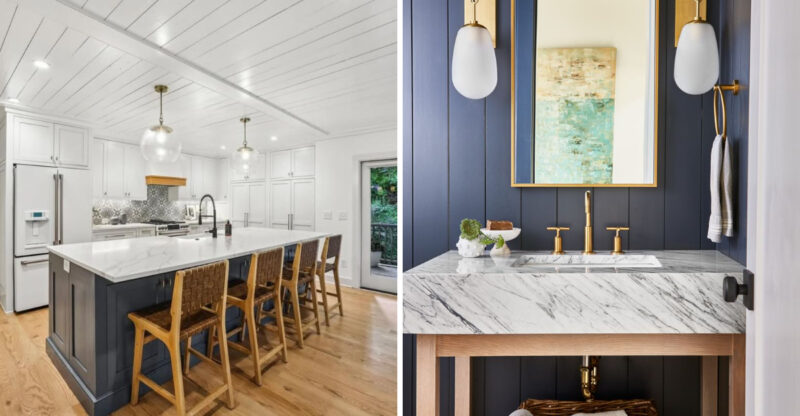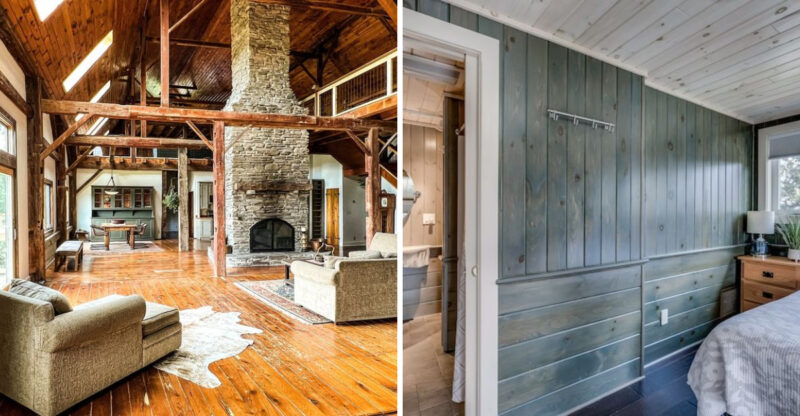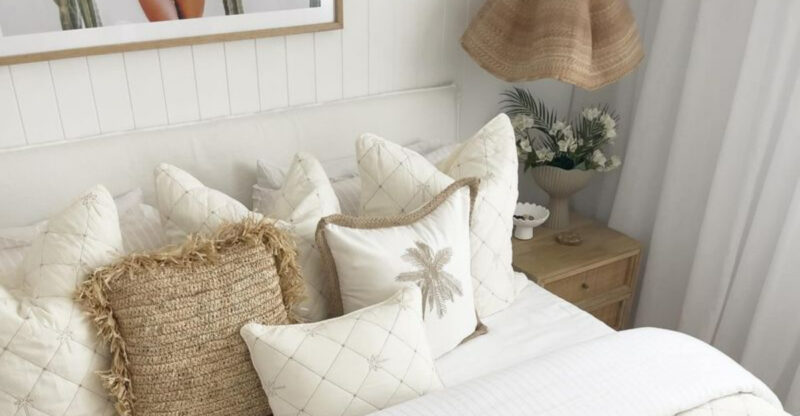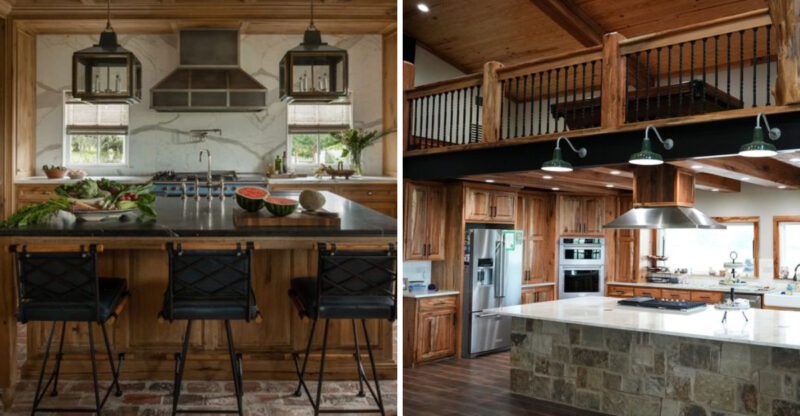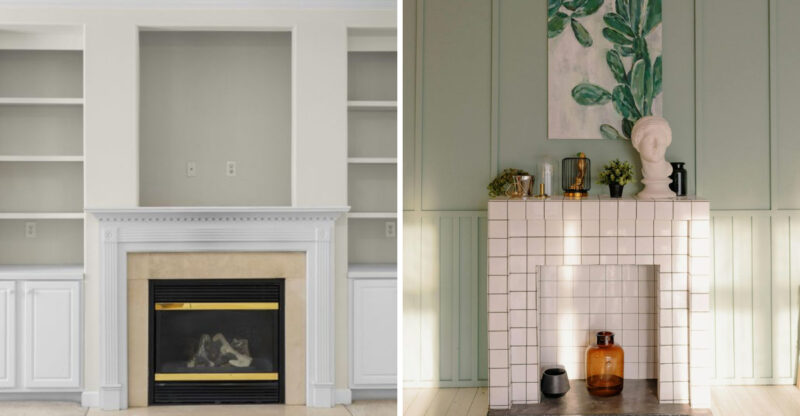The Essential Guide to Choosing the Right Area Rug Size

This post contains affiliate links, which means we may earn a small commission if you purchase through them — at no additional cost to you. Please see our policy page for more details.
In this article, we’re sharing the ultimate area rug size guide for every room. From living rooms to bedrooms, dining areas to entryways, our expert advice will ensure you find the ideal rug dimensions to enhance both the aesthetics and functionality of your room.
Selecting the right area rug size is a crucial aspect of interior design that can significantly impact the overall look and functionality of a room. A properly sized rug serves as the foundation of the room’s design, anchoring furniture arrangements, adding comfort and warmth, and defining specific areas within an open floor plan.

If you are looking for a rug size guide for a specific space, such as a living room or bedroom – read on.
Living room Rug Size Guide
Let’s talk for a minute about rug placement, as where you place the rug in the living room will determine the proper size. The most common approach, and the one that I find most pleasing to the eye, is to center the rug under key furniture pieces, such as sofas or dining tables.

With this rug placement, it’s important for the two front legs of every piece of furniture to be on the rug – this creates a cohesive and connected feel. Otherwise, that one lonesome chair completely off the rug in the corner looks like a little island, disjointed and weird.

Expert Tip: When positioning a rug in your living room or dining area, ensure that all front furniture legs are placed on the rug. This creates a cohesive and visually appealing arrangement, anchoring the furniture pieces together and defining the seating area.
In terms of size guidelines, it’s crucial to consider both the dimensions of the room and the layout of the furniture. You want to choose a rug size that allows ample coverage of the central seating area while leaving enough space around the edges for the room to breathe. You don’t want a rug that’s basically wall-to-wall carpet, right? You want a little border around the outside.
- 9×12 or 10×14 rugs are suitable for spacious rooms with dimensions of at least 12×16 feet.
- An 8’x10′ rug suits rooms measuring 11×14 or open floor plan settings.
- In smaller living rooms less than 11×14, a 5’x7’ or 6’x9′ rug is recommended.
Dining Room Rug Size Guide
Choosing the right rug size for your dining room is key to making it look good and work well. The rug should go under your dining table, making it the main focus of the room. To get it right, ensure the rug is big enough to stick out from under the table and hold at least the front legs of all the dining chairs.

You want to ensure your chairs have plenty of space to move without getting caught. Ultimately, the size of your dining table determines how big the rug should be so everything looks just right and fits together nicely in your dining area.
- For tables with eight or more chairs, opt for a 9×12 or 10×14 rug.
- For medium-sized tables of 6-8, an 8’x10′ rug is suitable.
- A round rug typically looks best for small tables of four, but a 6’x9′ rug is also recommended.
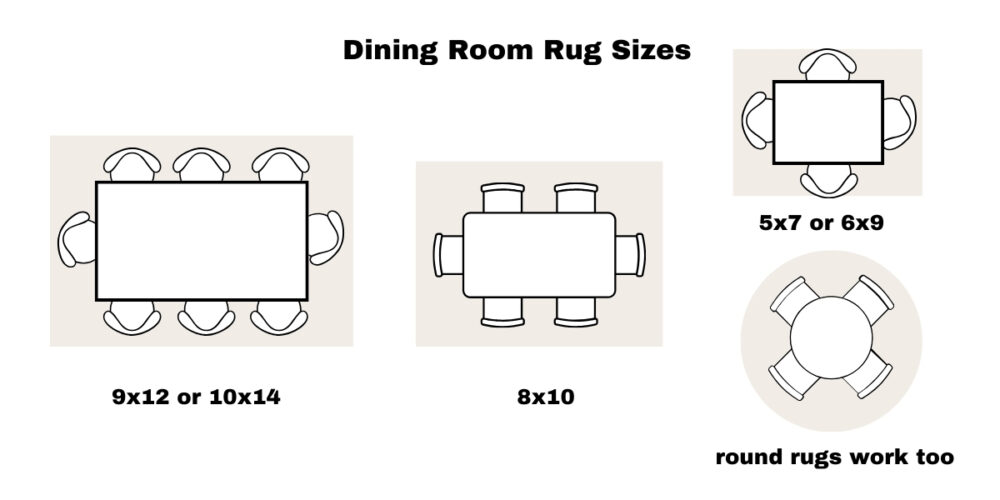
Expert Tip: When in doubt, go bigger. A rug that’s too small for the space will always look worse than a rug that’s too large for the space.
Bedroom Rug Size Guide
When it comes to placing a rug in your bedroom, you have a few options to consider, each offering a different look and feel to the space.
Under the Bed
The most common placement is under the bed. This is a popular choice as it anchors the room and adds warmth and comfort underfoot. This option allows the rug to extend beyond the sides and foot of the bed, creating a cohesive and inviting look. It’s a great way to define the sleeping area and add a plush landing spot when getting in and out of bed.
- For a twin bed: Opt for a rug size around 5’x8′ to 6’x9′.
- For a queen bed, Consider a rug size around 8’x10′ to 9’x12′.
- For a king bed, Choose a rug size around 9’x12′ to 10’x14′.
- Position the rug so it extends several feet beyond the sides and foot of the bed, creating a soft landing for your feet when getting in and out of bed.

Alongside the Bed
Another option is to place a rug alongside your bed, either on one or both sides. This adds visual interest and creates a cozy area next to the bed. Smaller or runner rugs work well for this placement, allowing you to customize the size and shape to fit your space. This placement works especially well with twin beds and beds pushed up against a wall, which you commonly see in children’s rooms.

In Front of the Bed
Lastly, you can place a rug in front of your bed, acting as a stylish focal point for your room. This option works well if you have a larger bedroom or if you prefer a more open and airy feel. A rug with this placement will really vary in size, but again, bigger is usually better than a small doormat size, which would look incredibly puny compared to a bed.
Hallway Rug Size Guide
When selecting a rug size for your hallway, it’s important to consider the flow of foot traffic. A narrow runner rug is often the best choice, providing a clear path while adding style and texture to the space. Additionally, the rug should ideally extend the entire length of the hallway for a cohesive look.
You can use multiple smaller runner rugs (that are the same) to fit the space. It’s also crucial to consider the doors along the hallway and ensure that the rug doesn’t obstruct their opening and closing. Measure the clearance space required for doors to swing freely, and choose a rug size that allows for unimpeded movement to maintain the space’s functionality.
Kitchen Rug Size Guide
These same rules for hallway rugs can be applied to kitchen rugs—the area between the wall cabinets and the island in a kitchen. Typically, a runner is the best choice here as it draws the eye in and defines the space while providing soft cushioning under your feet.
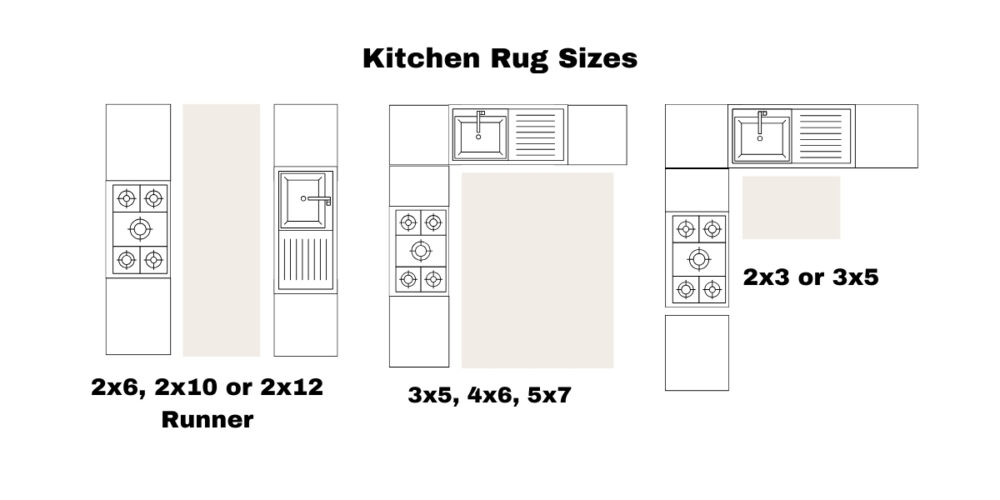
Just like in a hallway, you want to make sure the rug extends the entire length of this area in the kitchen. In some larger kitchens, this could be as long as a 2×10 or 2×12. Trust me, it will feel much larger this way!
Expert Tip: Consider purchasing a washable rug for high-traffic spaces, such as kitchens.
If you have a large open kitchen with no island, a rectangular rug that is sized to fit most of that middle area will look great – provided you leave a little border around the edges. Alternatively, if you want to leave most of the floor bare, you can always opt for a smaller kitchen sink rug, typically 2×4 or 3×5. I always think it’s nice to have some comfort under our feet while washing dishes.
Bathroom Rug Size Guide
When it comes to selecting the right size rug for your bathroom, consider the following guidelines:
Sink Area
When placing a rug in front of the sink, opt for a small runner or standard rug such as a 2’x3′ or 3’x5′. This provides comfort and protection for your feet while standing at the sink and prevents water from splashing onto the floor. If you have a double vanity, a long runner looks ideal, as it doesn’t break up the design flow. However, you can also opt for two smaller standard-size rugs.
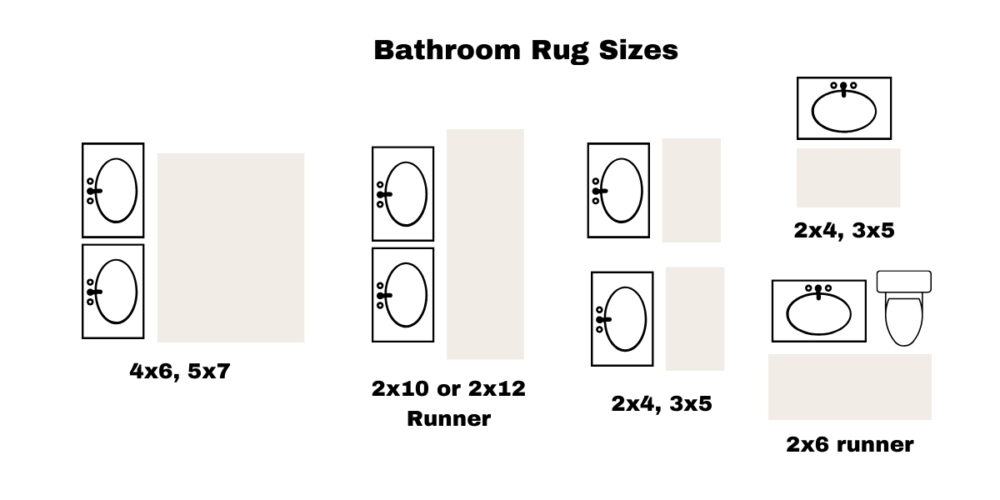
Toilet Area
Ugh, the toilet area. I prefer no rug around the toilet area, but my husband disagrees. He doesn’t like the feel of the cold tile under his feet. In this case, we opted for a very small rug that measures 2×3. I would avoid those rugs that go around the toilet – they can look very dated.
Bathtub or Shower Area
Consider placing a larger rug or bath mat outside the bathtub or shower to absorb water and prevent slipping. A rug size of around 2’x4′ or 3’x5′ is suitable for this area, providing ample coverage and comfort for stepping out of the tub or shower.
Overall Bathroom Size
If you have a larger bathroom with ample floor space, you may want to consider a larger rug or runner rug to add warmth and style to the space. A rug size around 5’x7′ can work well in a larger bathroom, providing a central focal point. This is exactly what we did in our bathroom (see the photo below with our Ruggable Rug), as we wanted color and comfort (and to hide that tile as much as possible, which is not my favorite!)
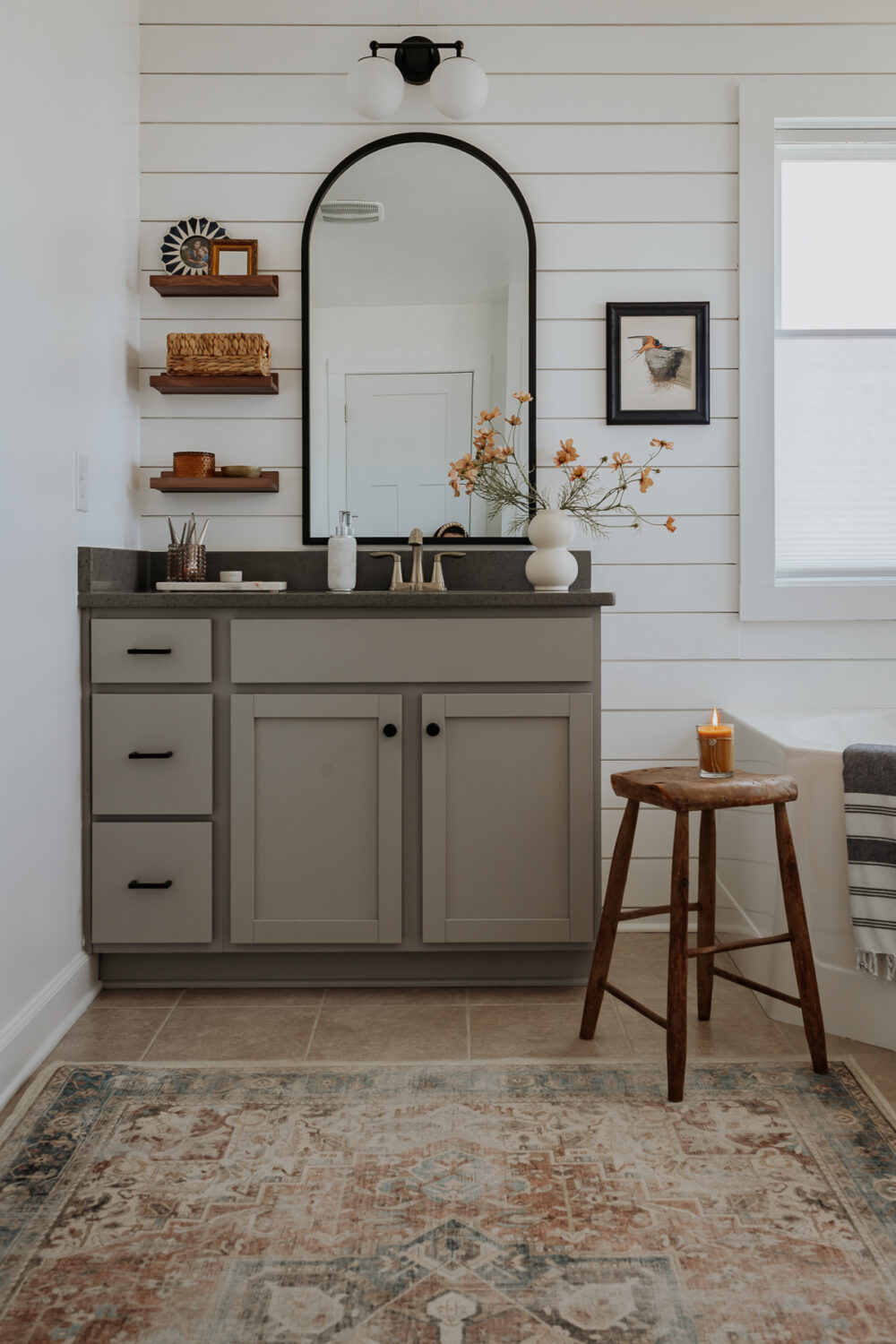
Entryway Area Rug Size Guide
If you have an open entryway, floating a rug is a fantastic way to further define the space. Floating means that the rug sits on the floor without any furniture on it. This approach works particularly well in open-concept spaces or rooms with non-traditional layouts, where the rug can define specific zones without confining the furniture to a predetermined arrangement. Typical area rug sizes in this case are 5×7, 6×9, or 8×10.

In this case, you’ll want a rug that covers most of this entryway space with a border of 18-24 inches around the edges. However, another common approach is opting for a rug to sit right by the front door. The rug should at least match the size of your front door or, ideally, be larger. You don’t want to go smaller! If you have double front doors, you will need an even larger area rug to fill this space, typically a 4×6 or 5×7.
Common Area Rug Sizes
These days, you can find rugs of almost any size if you search hard enough; however, we don’t always have time for that. It’s much easier to plan out a room using common, easy-to-find rug sizes that are sold at a variety of retailers. Here’s a brief overview of common rug sizes, from rectangular to runner to round shape rugs.
Small Sizes:
2’x3′: Ideal for entryways, small accent areas, or bedside rugs (something to put your feet on when you wake up).3’x5′: Suitable for compact living rooms, under coffee tables, or as accent rugs in bedrooms. 4’x6′: Versatile size for small to medium-sized rooms, commonly used in living rooms or dining areas.
Medium Sizes:
5’x7′: Popular choice for medium-sized rooms, works well under dining tables or as a central focal point in living rooms6’x9′: Slightly larger option for medium-sized rooms, providing more coverage and space definition.
Large Sizes:
8’x10′: This is the standard size for larger living rooms or dining areas. It provides generous coverage while allowing furniture to sit partially on the rug. 9’x12′: This is ideal for spacious living rooms or dining areas, offering plenty of room for furniture arrangement and visual balance. 10’x14′: This is suitable for grand living rooms or expansive dining areas and provides ample coverage for large spaces.
Runner Sizes:
Narrow and elongated, commonly found in sizes like 2’x6′, 2’x8′ 2’x10′ and 2’x12′.Used for hallways, entryways, or alongside beds.
Round Sizes:
Available in diameters ranging from 4′ to 10′ or more. It adds visual interest and softens angular spaces, commonly used under round dining tables or entryways. Looks great when floated in a space.
More Tips and Tricks for Determining the Right Rug Size
How to Measure Your Space
When it comes to choosing the right rug size, the first step is to measure your space accurately. Grab a measuring tape (read how to read a measuring tape here) and jot down the dimensions of your room, including its length and width. Next, measure the furniture you plan to place on or around the rug, such as your sofa, dining table, or bed. These measurements will give you a clear idea of the rug size you’ll need to ensure everything fits comfortably.
Visualize it with Painter’s Tape
Sometimes, it’s hard to get a feel for how a rug will look in your space, especially when shopping online or in-store. That’s where painter’s tape comes in handy. Use painter’s tape to outline the proposed rug size on your floor and mimic the dimensions of the rug you’re considering. This technique allows you to see how the rug will fit in your room and helps you visualize the placement before making a purchase.
Consider the Room Shape
The shape of your room can have a big impact on the size and placement of your rug. In square or rectangular rooms, a similarly shaped rug often works best, providing a balanced and cohesive look. You may need to get creative with your rug placement for rooms with unique shapes, like L-shaped or irregular layouts. Consider using multiple smaller rugs to define different areas within the room, or opt for a custom-sized rug that fits your space perfectly.
Leave A Border around the Outside
Again, we don’t want wall-to-wall carpet with our area rugs. To avoid this, aim to leave a border of at least 18 to 24 inches between the edge of the rug and the room’s walls. This creates a sense of balance and allows the rug to breathe within the space. Additionally, leaving some floor space exposed around the edges of the rug helps to visually expand the room and prevent it from feeling overcrowded.
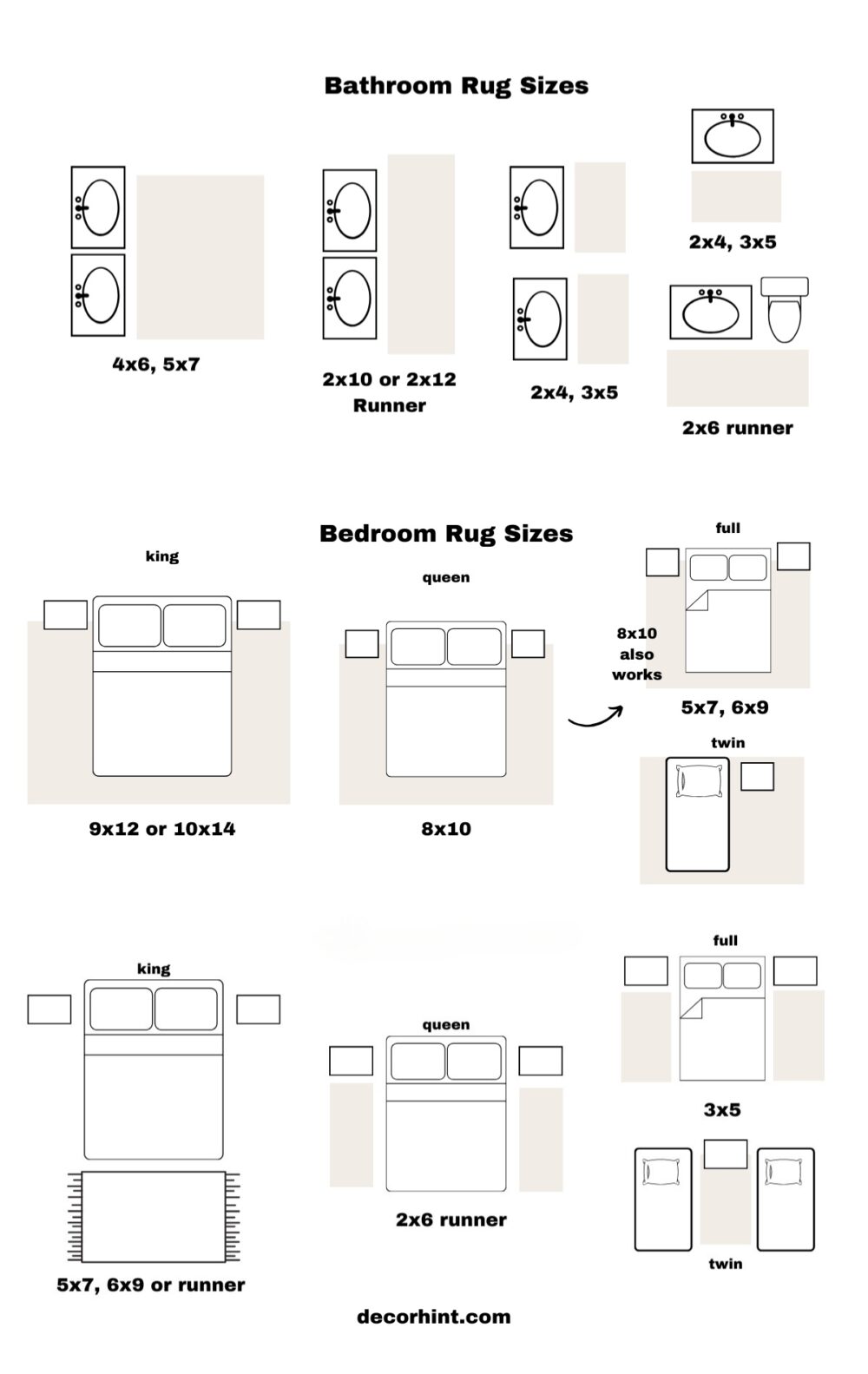
Frequently Asked Questions
-
How do I know if a rug is too small or too large for a room?
Firstly, observe how your furniture looks with the rug. Strive for a balanced arrangement where all key furniture pieces sit comfortably on the rug without overcrowding the room. Additionally, assess the visual balance within the space.
Secondly, consider the scale of the room itself when selecting a rug. In a large room, a small rug may seem out of place and make it look much smaller than it is, while a rug that fills the entire space could make it feel cramped.
Lastly, ensure there’s adequate border space between the rug and the walls to create a balanced look. -
Should I place furniture entirely on the rug or partially off?
You can really do either; however, for the most pleasing and cohesive look, the two front legs of all the furniture should be placed on the rug.
-
Can I layer rugs for added style and texture, and how does this affect sizing?
Layering rugs is a creative placement option that adds depth and texture to a room. By layering a smaller rug on top of a larger one, you can introduce visual interest and dimension while protecting high-traffic areas or adding warmth to hardwood floors. Whether centered under furniture, floating in the room, or layered for added depth, the placement of a rug can significantly impact the overall look and feel of a space, enhancing its functionality and aesthetic appeal. I most commonly see this with a large neutral rug underneath (like a jute rug) and a layered vintage or more colorful rug on top. This can be a fantastic way to save on your budget, as jute rugs tend to be more cost-effective than vintage rugs.
-
How much border space should I leave between the rug and the walls?
A general rule of thumb is to leave 18-24 inches of space between the rug and the wall.
-
Are there any special considerations for rug sizing in open-concept or irregularly shaped rooms?
The shape of your room can have a big impact on the size and placement of your rug. In square or rectangular rooms, a similarly shaped rug often works best, providing a balanced and cohesive look. If you have a round dining room table, an appropriately sized round rug can look amazing. You may need to get creative with your rug placement for rooms with unique shapes, like L-shaped or irregular layouts. Consider using multiple smaller rugs to define different areas within the room, or opt for a custom-sized rug that fits your space perfectly.
-
What size Rug for a King Bed?
Choose a rug size from 9’x12′ to 10’x14′. This ensures that the rug is big enough to center the king bed on. If you prefer not to have a rug under your king bed, you can opt for two runner-size rugs on either side of the bed. Or, if you have enough space in front of the bed, one larger rug, such as a 6×9, can look great floated in this space.
We hope this area rug size guide has provided valuable insights and practical tips to help you choose the perfect area rug size for your home.
Now, over to you! Please feel free to leave a comment below with any questions, thoughts, or experiences you’d like to share. We look forward to hearing from you and continuing the conversation on creating beautiful and functional living spaces together!

